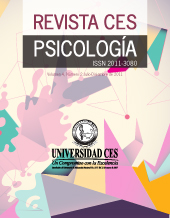Significant Moments in Psychotherapy with Children: A Study on Change Processes
DOI:
https://doi.org/10.21615/cesp.13.3.6Keywords:
Child Psychotherapy, Significant Moments, Psychotherapy Process ResearchAbstract
Objective: identify and describe significant moments in psychotherapy with children to understand the process of change in child psychotherapy from the subjective experience of the participants and the observation of psychotherapeutic sessions. Methodology: multiple case study in which four psychotherapeutic processes were analyzed from an interpretive paradigm and with a methodology oriented to discovery. All the psychotherapy sessions were recorded, semi-structured interviews were conducted with the different participants (children, parents, and therapists), and the analysis of important moments of the psychotherapeutic treatment was focused. Results: the article discusses the findings around the Significant Moments as a method for the study of change and at the same time, as a comprehensive phenomenon in the processes of psychotherapeutic change; in this sense, it offers a methodological and conceptual contribution as a result of the study. This research maintains that a Significant Moment in therapy is essentially a transitional and intersubjective phenomenon that works as a container and content of psychotherapeutic change. It is a transitional phenomenon because it occurs in an ambiguous dimension that involves simultaneously the internal and external; It cannot be defined as a completely objective or completely subjective experience, but rather a phenomenon that encompasses both dimensions. Conclusion: Significant Moments function as the container and content of the psychotherapeutic change processes. Continent as they frame, they delimit the study of therapeutic change; content because they themselves are a process.
Downloads
References
Alamo, N. (2019). Contenidos y evolución del cambio en la psicoterapia con niños y niñas: propuesta de un modelo genérico y de proceso (Tesis doctoral). Facultad de Ciencias Sociales, Escuela de Psicología, Pontificia Universidad Católica de Chile, Santiago, Chile.
Andersson, G., Boethius, S., Svirsky, L., & Carlberg, G. (2006). Memories of significant episodes in psychotherapy: an autobiographical memory approach. Psychology and Psychotherapy: Theory, Research and Practice, 79(2), 229-236. https://doi.org/10.1348/147608305X53198
Ávila-Espada, A. (2005). Al cambio psíquico se accede por la relación. Intersubjetivo. 7 (2), 195-220. https://www.psicoterapiarelacional.es/portals/0/Documentacion/AAvila/A_Avila_Al%20cambio%20psiquico_V7N2.pdf
Capella, C., Rodríguez, L., Aguila, D., Dussert D., Lama, X., Gutiérrez, C., & Beiza, G. (2015). Storied images of psychotherapeutic change: Approaching children´s voices through drawings. Research in Psychotherapy: Psychopathology, Process and Outcome, 18(2), 141-151. https://doi.org/10.4081/ripppo.2015.188
Carlberg, G. (1999). Turning points in child psychotherapy: Psychotherapists’ experiences of change processes. Estocolmo: Departamento de Educación, Universidad de Estocolmo.
Castrillón, L. (2008). Proceso de cambio en psicoterapia con niños: un estudio con momentos significativos. (Tesis doctoral). Facultad de Ciencias Sociales y Humanas, Universidad de Antioquia, Medellín, Colombia.
Castrillón, L., & Vanegas, J. (2019). Visión histórica y estado actual de la investigación en psicoterapia con niños. Revista Argentina de Clínica Psicológica, 28(5), 958-966. https://doi.org/10.24205/03276716.2018.1084
Coderch, J. (2012). Realidad, Interacción y Cambio Psíquico: La práctica de la psicoterapia relacional II. Madrid: Ágora Relacional.
Di Bártolo, I. (2016). El apego: Cómo nuestros vínculos nos hacen quienes somos. Buenos Aires, Argentina: Lugar Editorial.
Duarte, J., Martínez, C., & Tomicic, A. (2019). Revisión teórica y metodológica de los eventos relevantes en psicoterapia para el estudio del cambio. Revista Argentina de Clínica Psicológica, 28(3), 253-265. https://doi.org/10.24205/03276716.2019.1141
Duncan, S., Rice, L. N., & Butlei, J. M. (1968). Therapist's paralanguage in peak and poor psychotherapy hours. Journal of Abnormal Psychology, 73, 566-570.
Elliott, R. (1983). “That in your hands”: A comprehensive process analysis of a significant event in psychotherapy. Psychiatry, 46, 113-129.
Elliott, R. (1984). A discovery-oriented approach to significant change events in psychotherapy: Interpersonal process recall and comprehensive process analysis. En L. Rice, & L.S. Greenberg (Eds), Patterns of change: Intensive analysis of psychotherapy process. (pp. 249-286). Nueva York: Guilford.
Elliott, R. (2011). Qualitative Methods for Studying Psychotherapy Change Processes. En D. Harper, & A. R. Thompson, Qualitative Methods for Studying Psychotherapy Change Processes (págs. 69-81). Chichester, UK: Wiley-Blackwells.
Elliott, R., & Shapiro, D. A. (1992). Client and therapist as analysts of significant events. En S. G. Toukmanien & D.L. Rennie (Eds.), Psychotherapy process research: Paradigmatic and normative approaches. (pp. 163-186). Newbury Park, CA: Sage.
Esquivel, F. (2010). Capítulo 1. Reseña histórica de la psicoterapia infantil. En F. Esquivel (Ed.), Psicoterapia infantil con juego: casos clínicos (pp. 1-28). México: El Manual Moderno.
Flick, U. (2007). Introduacción a la investigación cualitativa (Segunda edición ed.). Madrid: Ediciones Morata.
Flick, U. (2015). El diseño de investigación cualitativa. Madrid: Ediciones Morata.
Gibbs, G. (2012). El análisis de datos cualitativos en investigación cualitativa. Madrid: Ediciones Morata.
Gonçalves, M., Matos, M., & Santos, A. (2009). Narrative therapy and the nature of "innovative moments" in the construction of change. Journal of Constructivist Psychology, 22, 1-23. https://doi.org/10.1080/10720530802500748
Graff, H., & Luborsky, L. (1977). Long-term trends in transference: A report on a quantitative-analytic method applied to four psychoanalyses. Journal of the American Psychoanalytic Association, 25, 471-496.
Harrison, A. (2003). Change in psychoanalysis: Getting from A to B. Journal of the American Psychoanalytic Association, 51(1), 221-256. https://doi.org/10.1177/00030651030510011201
Hill, C. E., Carter, J. A., & O'Farrell, M. K. (1983). A case study of the process and outcome of time-limited counseling. Journal of Counseling Psychology, 30. 3-18.
Hill, C. E. (1990). Exploratory in-session process research in individual psychotherapy: A review. Journal of Consulting and Clinical Psychology, 58, 288-294.
Hoyt, M. F. (1980). Therapist and patient actions in "good" psychotherapy sessions. Archives of General Psychiatry, 37, 159-170.
Kazdin, A.E. (1995). Bridging Child, Adolescent, and Adult Psychotherapy: Directions for Research. Psychotherapy Research, 5(3), 258-277.
Kazdin, A.E. (2000). Developing a research agenda for child and adolescent psychotherapy research. Archives of General Psychiatry, 57, 829-835.
Kazdin, A. E. (2009). Understanding how and why psychotherapy leads to change. Psychotherapy Research: Journal of the Society for Psychotherapy Research, 19(4–5), 418–428. https://doi.org/10.1080/10503300802448899
Kazdin, A. E., & Weisz, J. R. (2010). Introduction: Contex, Background. En J. R. Weisz, & A. E. Kazdin (Eds.), Evidence- Based Psychotherapies for Children and Adolescents (2nd ed., págs. 3-9). New York, EEUU: Guilford Press.
Kennedy, E., & Midgley, N. (2007). Process & Outcome Research in Child, Adolescent and Parent-Infant Psychotherapy: A Thematic Review. London: NHS London.
Krause, M., De La Parra, G., Arístegui, R., Dagnino, P., Tomicic, A., Valdés, N…. Ramírez, I. (2006). Indicadores Genéricos de Cambio en el Proceso Psicoterapéutico. Revista Latinoamericana de Psicología, 38(2), 299-325.
Kuhn, E. (2008). Avaliação Dos Resultados Da Psicoterapia Psicanalítica Com Crianças. (Tesis doctoral). Facultad de Psicología, Pontificia Universidad Católica do Rio Grande do Sul, Porto Alegre, Brasil.
Llewelyn, S. (1988). Psychological therapy as viewed by clients and therapists. British Journal of Clinical Psychology, 27, 223 - 238.
Mahrer, A. R., & Boulet, D. B. (1999). How to do discovery-oriented psychotherapy research. Journal of Clinical Psychology, 55, 1481-1493.
Marmar, C. R., Wilner, N., & Horowitz, M. J. (1984). Recurrent client states in psychotherapy: Segmentation and quantification. En L. N. Rice & L. S. Greenberg (Eds.), Patterns of change: Intensive analysis of psychotherapy process (pp. 194-212). New York: Guilford Press.
Matos, M., Santos, A., Goncalves, M., & Martins, C. (2009). Innovative moments and change in narrative therapy. Psychotherapy Research,19, 68-80. https://doi.org/10.1080/10503300802430657
MAXQDA Introducción. (2007). VERBI Software. http://www.maxqda.com/download/mx2007intro_esp.pdf
Midgley, N. (2004). Sailing between Scylla and Charybdis: Incorporating qualitative approaches into child. Journal of child psychotherapy, 30(1), 89-111. https://doi.org/10.1080/0075417042000205814
Midgley, N. (2007). Researching the process of psychoanalytic child psychotherapy. En E. Kennedy & N. Midgley (Eds.), Process and outcome research in child and parent-infant psychotherapy: A thematic review (pp. 8-53). London: NHS.
Mitchell, S. (1993). Conceptos Relacionales en Psicoanálisis, una integración. México: Siglo XXI.
Orlinsky, D. E., & Howard, K. I. (1967). The good therapy hour. Archives of General Psychiatry, 16, 621-632.
Congreso de la República de Colombia. (2006). Ley 1090 de 2006 por la cual se reglamenta el ejercicio de la profesión de Psicología, se dicta el Código Deontológico y Bioético y otras disposiciones. Ministerio de la Protección Social.
Rice, L., & Greenberg, L.S. (1984). Patterns of change. Nueva York: Guilford.
Russell, R. (2008a). Approaches to measuring change in child psychotherapy. En G. Carlberg, P. Eresund, & S. Boalt Boëthius (Ed.), Child and Adolescent Psychotherapy Research. Workshop for Clinicians and Researchers at the Erica Foundation (págs. 15-17). Stockholm: Ericastiftelsen (Erica Foundation).
Shirk, S., & Russell, R. (1996). Change processes in child psychotherapy. Revitalizing treatment and research. New York: The Guilford Publications.
Stern, D.N. (2004). The Present Moment in Psychotherapy and Everyday Life. Nueva York: W.W. Norton.
Timulak, L., & Elliott, R. (2003). Empowerment Events in Process-Experiential Psychotherapy of Depression: An exploratory qualitative analysis. Psychotherapy Research, 13, 443-460.
Timulak, L. (2007). Identifying core categories of client identified impact of helpful events in psychotherapy – a qualitative meta-analysis. Psychotherapy Research, (17), 305–314.
Timulak, L. (2010). Significant events in psychotherapy: An update of research findings. Psychology and Psychotherapy: Theory, Research and Practice, 83(4), 421-447.
Downloads
Published
How to Cite
Issue
Section
License
Copyright (c) 2020 CES Psicología

This work is licensed under a Creative Commons Attribution-NoDerivatives 4.0 International License.
Each manuscript is accompanied by a statement specifyingThat the materials are unpublished, that have not been previously published in printed formatElectronic and that they will not be presented to any other means before knowing the decision of the magazine. ThroughoutIn case, any previous publication, sea in printed or electronic form, must be made known to the editorial staffWriting The authors attach a signed statement stating that, and the manuscript is acceptedFor publication, the rights of reproduction are the exclusive property of the Journal CES Psychology.| Article metrics | |
|---|---|
| Abstract views | |
| Galley vies | |
| PDF Views | |
| HTML views | |
| Other views | |




